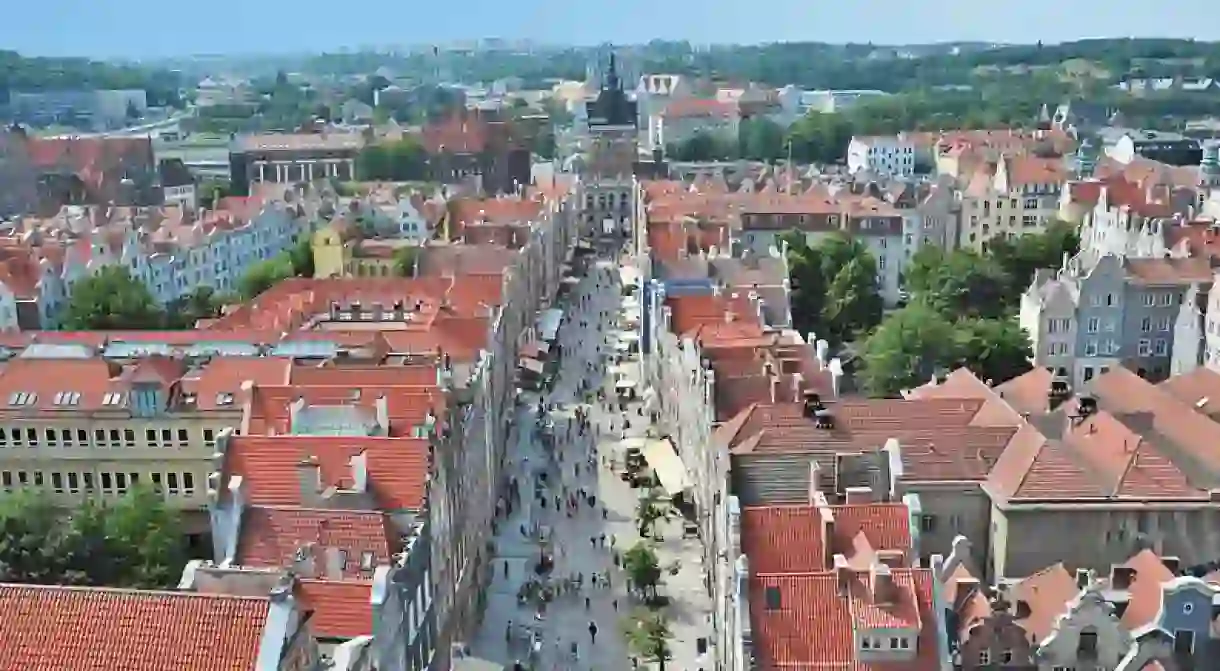A Tour of Gdańsk's Architectural Landmarks

Gdańsk is a gorgeous Polish city sitting on the Baltic coast – rich in history, culture and tradition, it has an architectural legacy as striking as its past. Want to find out more? Then take a look at our round-up of Gdańsk’s must-visit architectural landmarks.

Gdańsk Głowny Train Station
Begin your tour at Gdańsk Głowny, which is the main train station. Its iconic tower is a prominent building and one that marks many an entrance to the city. This train line has served Poland’s Baltic Coast since 1900 and continues to provide good train routes all over Poland.

Berlin Wall and Solidarność Wall remnants

On Rajska Street in Gdańsk, there is a fragment of both the Berlin Wall and the wall at the Gdańsk Shipyard, both of which played a huge part in the fall of communism. Aside from the wall remnants, there is a ‘walk of freedom’ path which leads to Gdańsk shipyard.
Monument for the Fallen Shipyard Workers
This huge monument by the shipyard is dedicated to the shipyard workers who died in 1970, long before the Solidarnosc movement. It is one of three architectural landmarks on the tour that are related to the shipyard, which sits in behind the monument.
European Solidarity Centre
Museum

Gdańsk played a huge part in the fall of communism and a lot of the events took place here by the shipyard. Lech Wałęsa led the Solidarność (Solidarity) movement of the 1980s and the area now houses the huge European Solidarity Centre which is a museum and education centre.
St. Mary’s Basilica
The huge St. Mary’s Basilica is rumoured to have more red bricks than any other church in the world. It is a splendid building that sits on Gdańsk’s Ulica Piwna. The interior has white walls and holds regular masses while the highlight for many is walking the steps to the top for splendid views over the city.

St. Mary’s Basilica | © Thomas Quine / Flickr
Gdańsk Post Office
Building, Post Office, Museum

This post office in Gdańsk also marks a pivotal point in European history, as it was here on the fateful morning of September 1, 1939 that the Germans stormed the building, killing many innocent people in an attack that started World War II. The post office is still in operation but the building now houses a museum and has many memorials and monuments outside as a dedication to those who died.
Falowiec
Building
Falowi… what? Falowiec! Believe it or not, this is the longest residential building in Europe and it is here in Gdańsk, for this reason it is worth a visit. It is located in the city’s Nowy Port area so will require a tram or bus ride from the Old Town, but it’s a fantastic piece of architecture which houses nearly 6,000 people.
The Bunker at Westerplatte
Building
OK, so officially the Bunker is a destroyed piece of architecture, but for pure historic relevance it would seem odd to skip it from such as list. This bunker was used as a shelter during World War II and although mostly destroyed, the building’s shell remains. Westerplatte | © Northern Irishman in Poland
Neptune’s Fountain
Market

Right in the centre of Gdańsk’s Długi Targ (Long Market) sits this instantly recognisable fountain with a statue of Neptune above it. A bronze sculpture dating back to the seventeenth century, Neptune’s Fountain is an absolute icon of Gdańsk and it would seem a little ridiculous to miss it on your jaunt through the centre of the city. Neptune’s Fountain, Gdansk | © Lukas Plewnia / Flickr
Old Town Hall (Ratusz Starego Miasta)
Building
Gdańsk actually has two Old Town Halls – and both have played a significant part in the city’s history. While the most visited one is the Ratusz with its famous clocktower, this building is older and in surprisingly good condition. Gdańsk Old Town Hall | © Yanek / WikiCommons
The Great Armoury
Building

This building is not actually open to the public so is best admired from the outside, but is the house where the weapons were stored. The exterior features some fine statues including the intriguing ‘lion with erect penis’.
Daniel Fahrenheit’s House
Daniel Fahrenheit who invented both the mercury-in-glass thermometer and the Fahrenheit scale, was born in this very city back in 1686. Not only can you visit his house, but also an original Fahrenheit thermometer sits in the Długi Targ in Gdańsk.
Gdańsk Town Hall (Ratusz)
Museum
The list features both of Gdańsk’s town halls and this one, known as the Ratusz, is the most photographed and the most famous. There is a museum inside and you can climb to the top for sublime views over the city.
Artus Court
Museum

Artus Court is an instantly recognisable piece of architecture which sits in the famous Długi Targ (Market Square / Long Market) right in front of the Ratusz. It is photographed daily hundreds of times by tourists and inside there is yet another museum.
The Crane (Żuraw)
Museum

Unmissable due to the fact that it sticks out and hangs over every other building on the same street, the Crane is a building down by the waterfront in Gdańsk. The Crane (in Polish, Żuraw) is no longer in use but there are information boards detailing its relevance through Gdańsk’s history.
The Golden Gate (Złota Brama)
Historical Landmark

Gdańsk’s famous Ulica Długa (Long Street) has a truly memorable and elaborate entrance on both sides with the gates. The Golden Gate was built in 1612-14, but has been reconstructed and repainted many times throughout the years.













